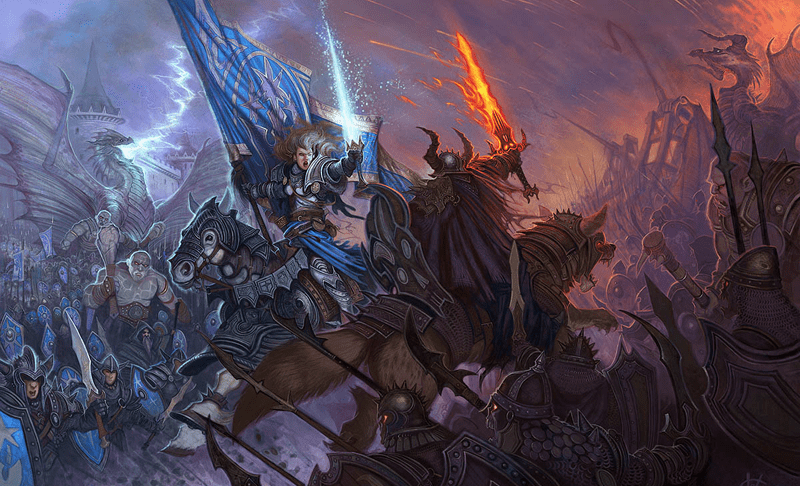Unearthed Arcana: Mass Combat Breakdown

If I had had to guess what we’d see in this week’s UA, I don’t think a new round of mass combat rules would have made the top 5, though probably the top 10. Not that you asked, but: the #1 spot easily would have gone to the mystic, followed by downtime rules that might have a hint of domain rulership flavor, followed by races or rules for some non-FR setting, then maybe another ranger iteration, and finally a warlord class or subclass (above and beyond the banneret from SCAG). These rules are a second iteration of an early UA article that is damn close to its second birthday.
I’ll be talking about comparative cases with the first mass combat document as much as possible, because if you’ve read any of the History of the Classes series, you know that design trends are as interesting as outcomes. The number-one-with-a-bullet change here is scale. We’ve shifted from a base of 20 combatants forming a unit to a base of 400. So, you know, that will probably have some impact. I criticized the first document fairly heavily for covering only large-skirmish-scale warfare, with no realistic ability to work with Pelennor Fields-level armies. Units of 400 may still be burdensome if you’re hoping to recreate historical or fictional battles, but it is a damn sight closer. Naturally, it’s still critical for D&D to support individual heroics, which – along with an innovative action economy – was a major strength of the first set of mass combat rules; let’s see what happens here.
This system cares about two core statistics: battle rating and morale rating. Battle rating is a conversion of the CR of all creatures in a unit; in this way a single high-value creature could hugely skew the BR of a unit. We may not be in the habit of calculating a PC’s CR, so it’s lucky for us that this document doesn’t do that. Character-scale combat comes at the end of the document, though. Anyway, there’s something a bit brain-breaking about having CR 20 creatures that don’t resolve as individual characters, in anything short of just staging the major engagements of the Blood War (where units of 400 are probably woefully insufficient). Creatures above CR 20 presumably are treated as individuals – but you could also just project the 1 CR = +4 BR pattern upward and call it a day.
Anyway, that 400 number I keep tossing around is space filled by Medium or smaller units; larger units take up more space, and thus you can fit fewer of them into a single unit. This prioritizes CR by density – that is, a Medium or smaller creature’s CR is more valuable than a larger creature’s CR. A unit of ogres (400/4, so BR 100) is in bad trouble against a unit of berserkers (400/1, so BR 400). For what it’s worth, the entries for ogres and berserkers both call out that they form units like I’ve just described. On the other hand, if you have 400 ogres divided into four units and 400 berserkers in one unit, the ogres have a huge lead on the action economy, right? Yes, but it will never, ever matter, because d20+100 never beats d20+400, so the ogres lose… not quite instantly, but they certainly don’t land a hit. In individual combat, this goes quite differently. Poking at the math a bit more, there aren’t many viable use cases.
Moving on, each unit has a commander, and that commander’s Cha modifier factors into morale rolls. The commander belongs to the unit but does not count toward determining its size.
The mounts of mounted units add their CR to the battle rating, but I’m not clear on how they factor into the 400-count limit. If the rules treat a warhorse as the Large creature that it is, then the CR ½ horse is a huge impediment to the unit strength of the CR 3 knight, using up 5 Medium-creature spaces to add 3.5 total CR.
Morale rating is a value between -10 and +10, determined by DM fiat and guided by the positive or negative influence of a series of factors. The Factors Affecting Morale list is solid, lacking only “recent defeat or victory,” except insofar as that’s a judgment of “incompetent or ill-prepared commanders.”
Battles operate on a scale of minutes rather than 6-second rounds, which is the right decision for the use case, and also a throwback to the round times of 2e and earlier, which were themselves holdovers from D&D’s wargaming roots. Movement gets rescaled to that amount of time, which is good, since the size of a unit – a square 100 feet on a side – is otherwise so large that a unit with a speed of 30 ft would still overlap with its starting space, even when Dashing. The big problem with multiplying speed to the minute-round scale is that a unit’s move brings it from outside a longbow’s max range to melee contact in a single move, so ranged weapons don’t accomplish much.
The initiative calculation is a fixed rank, not a roll. Many people all around the internet have noted that the commander’s Cha modifier factors twice in initiative, since it’s 10 + unit morale (which includes the Cha mod) + the commander’s Cha mod. Until further notice, I’ll assume this is an error and not an attempt to increase the impact of a high Cha, but it’s only initiative and doesn’t affect play nearly as much as you might think. The initiative rules note that the action economy behaves like normal, and units can move-attack-move like normal, but the rules on movement two paragraphs down and the difficulty of wiping out an enemy unit mean that we’re really just talking about ranged units doing this. Specifically, you must use the Disengage action and pass a morale check to leave adjacent contact with an enemy unit.
The Action Options are pretty straightforward, other than the piece I just mentioned about Disengage. The Attacks section, for how to resolve the contested BR roll, is another real problem. Let’s be real, 1d20 + a large number vs 1d20 + another large but not identical number is almost always going to be so far outside the spread of 1d20 that the Tie and Attacker Wins by 10 or Less outcomes can be safely ignored. Even if they couldn’t, a win by 10 or less degrading BR by 2 can be all but ignored when BRs scale in three or even four digits. When the defender wins the roll, nothing happens; when the attacker wins by 11 or more, the defender loses 5 BR (still trivial) and has to roll a morale check (the only actual danger here). For no apparent reason, a unit automatically escapes when its morale breaks. There are also ways to get advantage or disadvantage on each side of this contested roll, but as I’ve just explained, this won’t ever matter.
The rules for morale checks are fine, except that it could take hours of attrition to grind a unit down to half its starting BR, even when it loses every roll by 11 or more.
Next up is the rules for characters in mass combat, which boil down to “ignore everything that came before, zoom in, and resolve a few rounds of personal-scale combat.” This tries to provide for PC spellcasters to toss off spells that would matter in mass combat, like fireball or wall of ice, but it shines a harsh light on the contrast of effectiveness between personal and mass combat. All the worse, in fact, for spells with a duration.
There are a few DM hints about how to run a mass combat in a satisfying way, keeping the focus on the PCs and letting them face interesting named NPCs.
Whew. What can I say about this document? This is the first unmitigated failure that UA has released. All of my UA analyses necessarily point out negative things, but in general I think Mearls and Crawford do strong, compelling work. I don’t know what happened here, and from my own experience as a professional game designer, I know better than to speculate. Let me leave it at this: any two units that are not the same size and CR are all but guaranteed to be 20+ points apart in BR, and once that happens, there’s no game. The things that give a force a superior BR don’t follow from the fiction.
We’ve seen UA iterate a piece of rules through multiple steps before. It can be an erratic path, as it seems that the designers prefer to scrap the whole of the previous document and start fresh in many cases. I think we’ll see at least one more iteration before mass combat rules go official, and I expect that they’ll be phenomenal. Maybe they’ll do me a favor and come out right around when I’m working on a History of Mass Combat Rules series? A columnist can dream.



